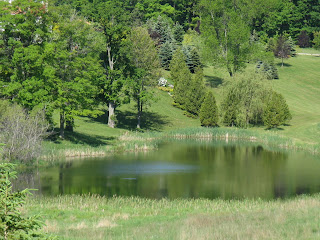If you are "always a student" you won't be able to find a bad winter for painting. This one was no different. We were out two or three times a week. Snow, blow, cold or melt, makes for great experiences. It helps that we have done this enough that we have developed ways and means. Looking for small valley shelters, hiding behind trees, working with snow on the palette - mixes well with oil, there is no bad winter weather. Ignore the forecast and get on with it.
This winter we observed a few things. It was not particularly cold. The snow at our northern painting area was lighter than in the southern area. In the south it was maybe average. There was no frost. The thaws were deep and fast. More wind than usual. Lots of moody skies. Standard was the simplifying effect and the eye training for colour and shape. We have only a 7 month wait for the next instalment.
Here are a few samples from March 2011. I painted larger this year so I refurbished the French easel for that. Up until last week I had never been blown down with it even with a larger canvas (30x30).
Alton, sunny and warm, -2C
Done along the creek beside the Alton Mill. As - is from plein air session.
Scotsdale Farm, cold, windy, sunny and cloudy
Stowe Vermont, late day winter light
I like to get to some unfamiliar areas to paint. So, while skiing.............
Hockley Valley, construction concepts
Cold and sunny, and familiar with the area.
Stowe on Skiis
Skiing keeps you warm. A near blizzard followed this. You feel lost up high.
Mistake Valley 9AM
Fell upon this little valley. A series is in process. 2 done in late March. Soon another visit.
Deer Family
This was the last hoorah in March. Done on the 31st. There were others in March. All of the above are in the "as - is" state after painting on site. Varying degrees of finish will be applied in the studio. I use the thumbnail with its notes and my memory to finish off the painting. Sometimes they fly as they are (signed). You can pick out areas to refine looking at these images.
Now we are in mud and stick season. My strategy to avoid that (it is almost over) this year is to do a series of townscapes. I have been out 5 times on that mission. Next week I head to New York City, then along the New England coast. Anything for a diversion, but always going out there.






















